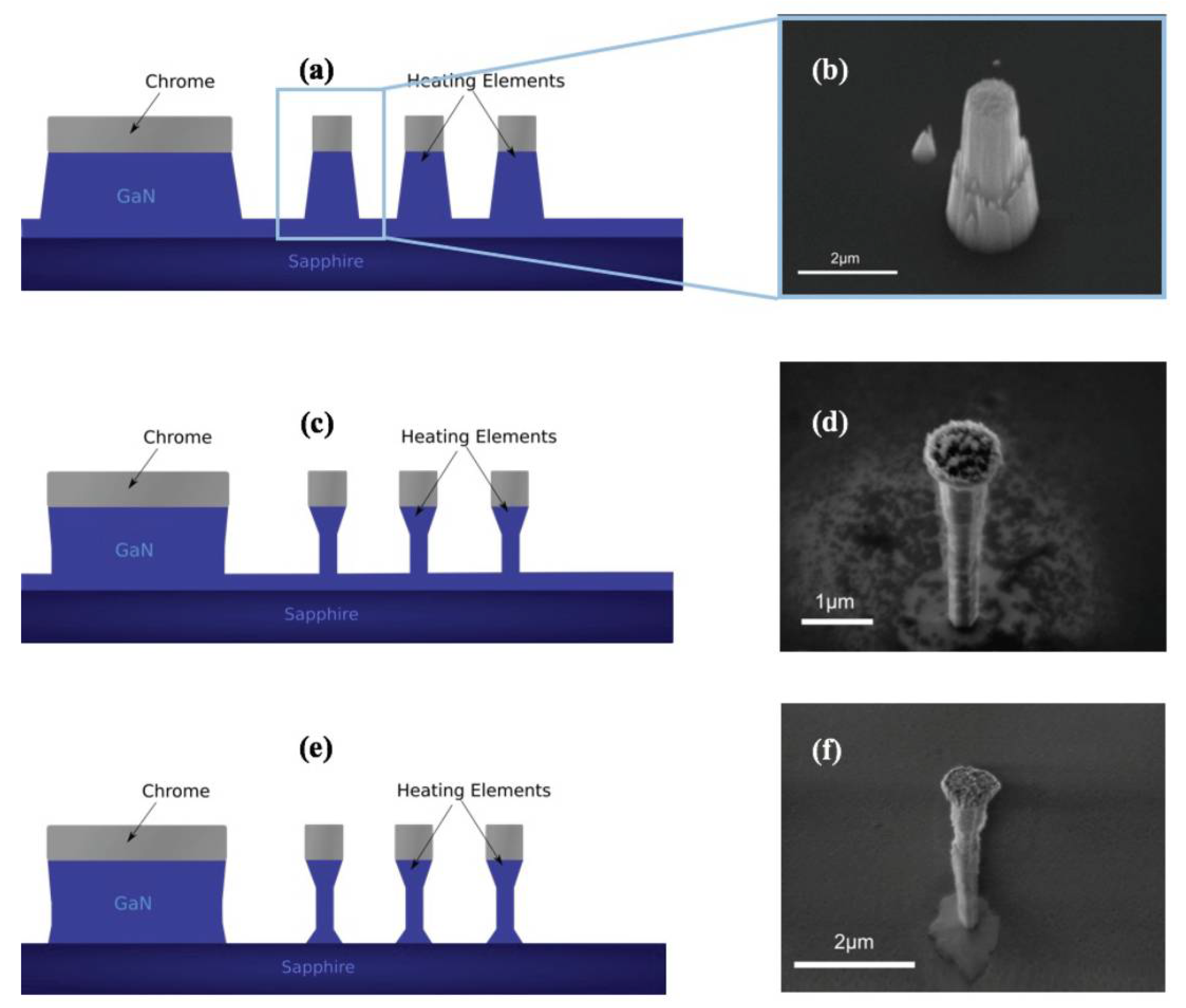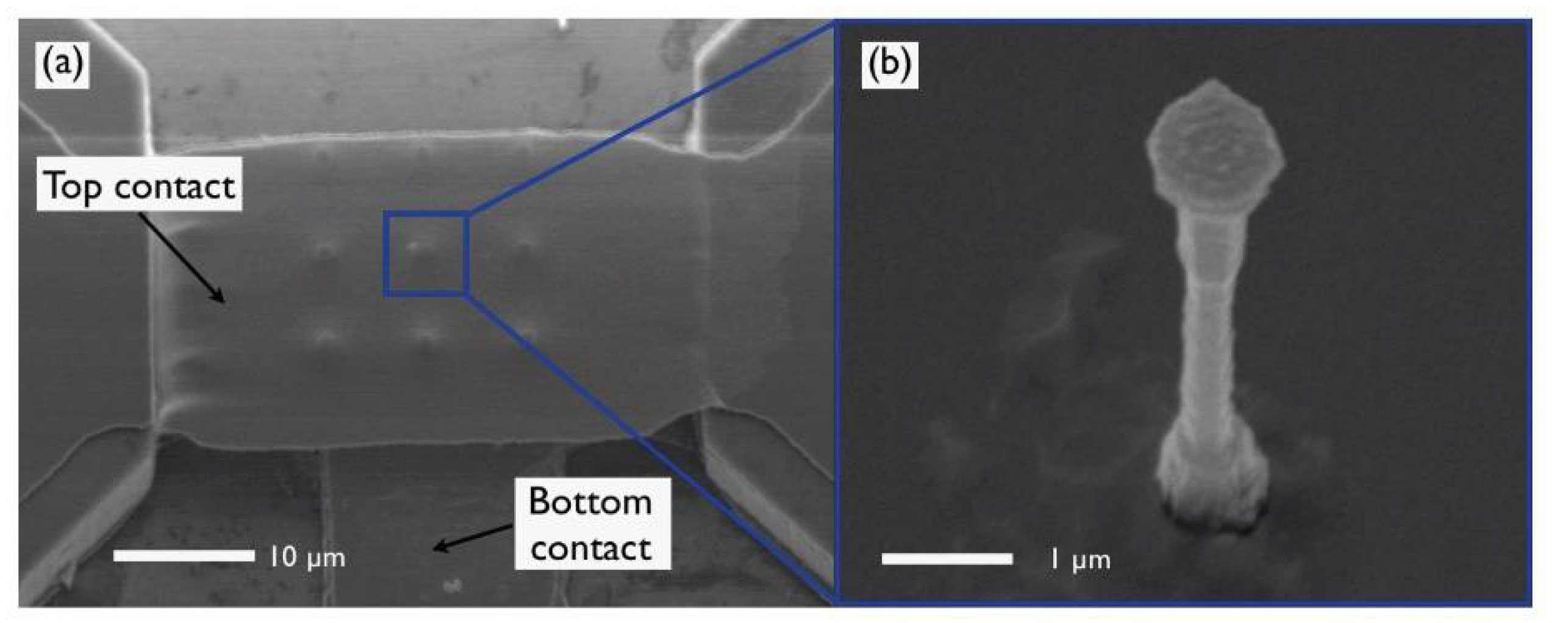Top-Down Fabrication of Arrays of Vertical GaN Nanorods with Freestanding Top Contacts for Environmental Exposure †
Abstract
:1. Introduction
2. Device Fabrication
3. Conclusions
Author Contributions
Acknowledgments
Conflicts of Interest
References
- Fabrega, C.; Casals, O.; Hernandez-Ramirez, F.; Prades, J.D. A review on efficient self heating in nanowire sensors: Prospects for very-low power devices. Sens. Actuators B 2018, 256, 797–811. [Google Scholar] [CrossRef]
- Wagner, A.; Bakin, A.; Otto, T.; Zimmermann, M.; Jahn, B.; Waag, A. Fabrication and Characterization of Nanoporous ZnO Layers for Sensing Applications. Thin Solid Films 2012, 14, 4662–4665. [Google Scholar] [CrossRef]
- Chikkadi, K.; Muoth, M.; Maiwald, V.; Roman, C.; Hierold, C. Ultra-low power operation of self-heated, suspended carbon nanotube gas sensors. Appl. Phys. Lett. 2013, 103, 223109. [Google Scholar] [CrossRef]
- Prades, J.D.; Jimenez-Diaz, R.; Hernandez-Ramirez, F.; Barth, S.; Cirera, A.; Romano-Rodriguez, A.; Mathur, S.; Morante, J.R. Ultralow power consumption gas sensors based on self-heated individual nanowires. Appl. Phys. Lett. 2008, 93, 123110. [Google Scholar] [CrossRef]
- Ramgir, N.; Datta, N.; Kaur, M.; Kailasaganapathi, S.; Debnath, A.K.; Aswal, D.K.; Gupta, S.K. Metal Oxide Nanowires for Chemiresistive Gas Sensors: Issues, Challenges a Prospects Colloids Surface A Physicochem. Eng. Asp. 2013, 439, 101–116. [Google Scholar] [CrossRef]
- Afshar, M.; Preiss, E.M.; Sauerwald, T.; Rodner, M.; Feili, D.; Straub, M.; König, K.; Schütze, A.; Seidel, H. Indium-tin-oxide single-nanowire gas sensor fabricated via laser writing and subsequent etching, Sens. Actuators B Chem. 2015, 215, 525–535. [Google Scholar] [CrossRef]
- Yu, F.; Yao, S.; Römer, F.; Witzigmann, B.; Schimpke, T.; Strassburg, M.; Bakin, A.; Schumacher, H.W.; Peiner, E.; Wasisto, H.S.; et al. GaN nanowire arrays with nonpolar sidewalls for vertically integrated field-effect transistors. Nanotechnology 2017, 28, 95206. [Google Scholar] [CrossRef] [PubMed]
- Yu, F.; Strempel, K.; Fatahilah, M.F.; Zhou, H.; Römer, F.; Bakin, A.; Witzigmann, B.; Schumacher, H.W.; Wasisto, H.S.; Waag, A. Normally Off Vertical 3-D GaN Nanowire MOSFETs with Inverted—GaN Channel. IEEE Trans. Electron Devices 2018, 65, 2439–2445. [Google Scholar] [CrossRef]
- Yu, F.; Rümmler, D.; Hartmann, J.; Caccamo, L.; Schimpke, T.; Strassburg, M.; Gad, A.; Bakin, A.; Wehmann, H.-H.; Witzigmann, B.; et al. Vertical architecture for enhancement mode power transistor based on GaN nanowires. Appl. Phys. Lett. 2016, 108, 213503. [Google Scholar] [CrossRef]



Publisher’s Note: MDPI stays neutral with regard to jurisdictional claims in published maps and institutional affiliations. |
© 2018 by the authors. Licensee MDPI, Basel, Switzerland. This article is an open access article distributed under the terms and conditions of the Creative Commons Attribution (CC BY) license (https://creativecommons.org/licenses/by/4.0/).
Share and Cite
Markiewicz, N.; Casals, O.; Fatahilah, M.F.; Strempel, K.; Gad, A.; Wasisto, H.S.; Waag, A.; Prades, J.D. Top-Down Fabrication of Arrays of Vertical GaN Nanorods with Freestanding Top Contacts for Environmental Exposure. Proceedings 2018, 2, 845. https://doi.org/10.3390/proceedings2130845
Markiewicz N, Casals O, Fatahilah MF, Strempel K, Gad A, Wasisto HS, Waag A, Prades JD. Top-Down Fabrication of Arrays of Vertical GaN Nanorods with Freestanding Top Contacts for Environmental Exposure. Proceedings. 2018; 2(13):845. https://doi.org/10.3390/proceedings2130845
Chicago/Turabian StyleMarkiewicz, Nicolai, Olga Casals, Muhammad Fahlesa Fatahilah, Klaas Strempel, Alaaeldin Gad, Hutomo Suryo Wasisto, Andreas Waag, and Joan Daniel Prades. 2018. "Top-Down Fabrication of Arrays of Vertical GaN Nanorods with Freestanding Top Contacts for Environmental Exposure" Proceedings 2, no. 13: 845. https://doi.org/10.3390/proceedings2130845
APA StyleMarkiewicz, N., Casals, O., Fatahilah, M. F., Strempel, K., Gad, A., Wasisto, H. S., Waag, A., & Prades, J. D. (2018). Top-Down Fabrication of Arrays of Vertical GaN Nanorods with Freestanding Top Contacts for Environmental Exposure. Proceedings, 2(13), 845. https://doi.org/10.3390/proceedings2130845




